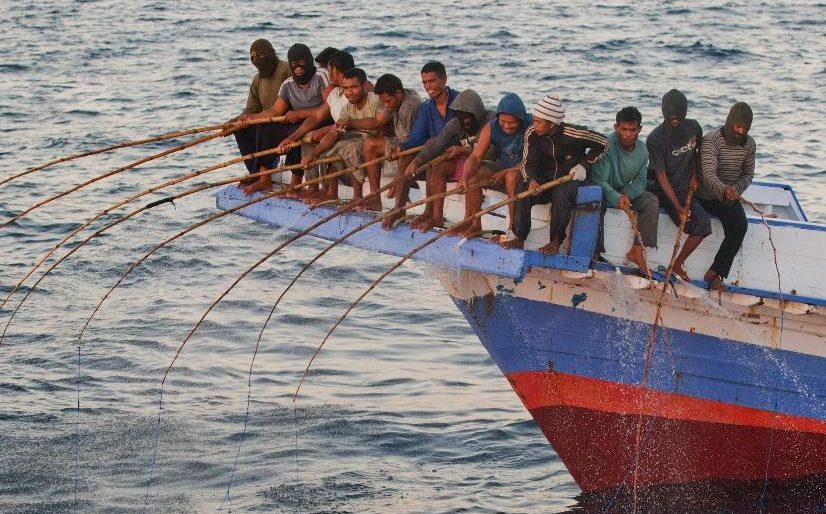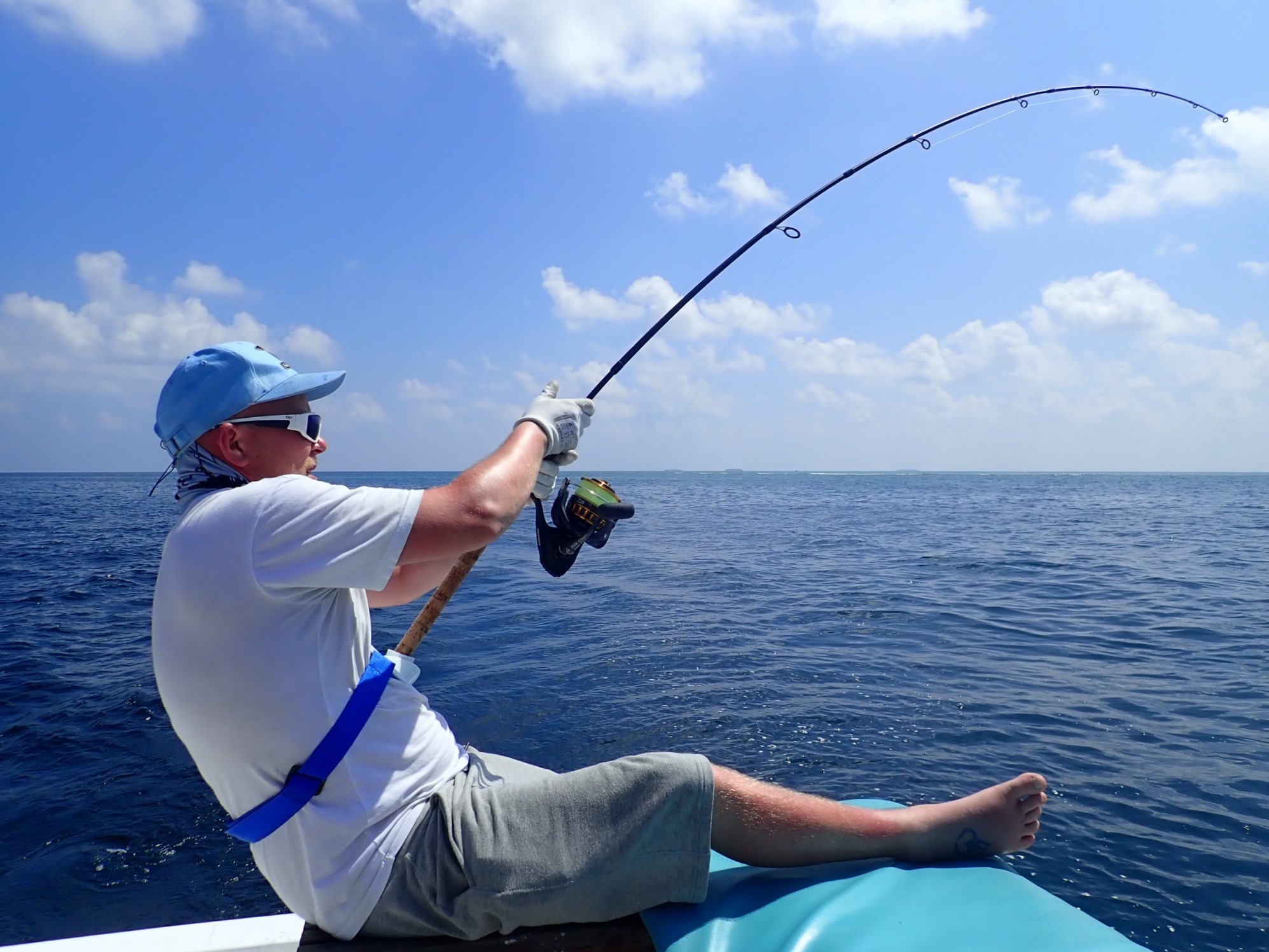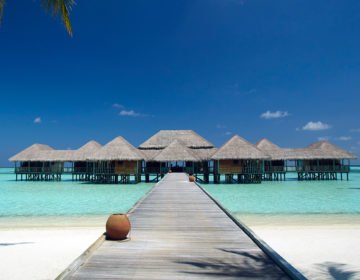The Maldives is renowned for being one of the ‘fishiest’ places on earth due to the vast diversity and variety of aquatic life, and the vital role it plays in the local culture. One of the primary economic industries in the country, the other of which is tourism, fishing is the lifeblood of the archipelagic nation with about 30 percent of the population working in the industry.
The fishing industry in the Maldives is the nation’s second-biggest industry next to tourism, employing half of the country’s workforce and providing a livelihood for much of the population. The Maldivian waters are home to an abundance of aquatic life and thousands of species of fish, ranging from small types such as snapper, squirrel fish, and parrot fish to large pelagic fish like grouper, giant trevally, and tuna. Fishing is a vital source of income for the country, which stems from both commercial and leisure fishing, and many of the islands have fishing-specific resorts that cater for leisure fishing vacations.
 Photo Credit: YouTube
Photo Credit: YouTube
History
Fishing has long been the primary source of income for the Maldives with tuna fishing being the greatest. The Maldives used to ship up to 90 percent of its fishing catch made up mostly of tuna in dried form to Sri Lanka. However, when Sri Lanka decreased the import of such fish in the 1970s, the Maldives joined with the Japanese Marubeni Corporation to form the canning and processing company, Maldives Nippon Corporation to can and process fresh fish. In 1979, the Maldivian government also created the Maldives Industrial Fisheries Company, which controls the processing and exporting of frozen and canned tuna, as well as providing collection vessels.
Several fisheries development projects have been undertaken with financial support from Japan and the World Bank with vast improvements in harbor and refrigeration facilities, leading to an increase in earnings from canned fish in the 1980s. The fishery industry was the dominant sector of the economy until 1985 when the tourism industry overtook the fisheries in terms of its contribution to GDP. However, the fishing industry continues to provide a vital source of income for about 20 percent of the population, with about 22,000 individuals involved in full-time fishing activities. (Source: Wikipedia)
 Photo Credit: YouTube
Photo Credit: YouTube
Exclusive Economic Zone (EEZ)
The Maldives has a 200-nautical-mile Exclusive Economic Zone (EEZ), which gives the fishing industry of the country exclusive rights and covers about an area of about 560,000 square miles where the Maldives can, under international law, fish.
For most coastal countries, the EEZ roughly coincides with the continental shelf, the fishing-rich area of relatively shallow water, which is usually less than 700 feet deep, that extends from most continental coastlines. The EEZ gives fishing and mineral rights to this shelf. (Source: Wikipedia)
 Photo Credit: Wikipedia
Photo Credit: Wikipedia
The Maldives, however, does not have a continental shelf as they are an archipelagic nation and not part of a continent. The coral atoll equivalent of a continental shelf are the shallow coral floors surrounding the islands and within the coral basins and lagoons. The total amount of non-submersed land area of the islands of the Maldives is about 190 square miles, and the total coral shelf area is approximately 21,800 square miles. Although the shelf area of the Maldives is 120 times larger than the land area, it is relatively small compared to the sections of deep-ocean that form part of the Maldivian Exclusive Economic Zone (EEZ).
There are four distinct areas in the Maldives where fisheries can operate, namely land areas, coral lagoons, the outer coral shelf, and the deep ocean.
Land Areas
The islands in the Maldives are too small to have inland lakes and rivers, so there are no inland fisheries or aquaculture activities (fish farming).
Coral Lagoons
Many of the islands in the Maldives have become submerged, leaving lagoons wholly or partially enclosed by a ring of coral, which teem with hundreds of species of reef fish and other aquatic life.
 Photo Credit: Holy Smithereens
Photo Credit: Holy Smithereens
Outer Coral Shelf
This shelf of coral slopes away steeply and does not offer as rich fishing grounds as the inner lagoons do.
 Photo Credit: LinkTV
Photo Credit: LinkTV
Deep Ocean
The sections of deep-ocean around the islands are by far the most significant part of the Exclusive Economic Zone (EEZ). These areas are inhabited by schooling forage fish, also known as baitfish, and the larger fish that feed on them, such as pelagic hunters (tuna, trevally, and grouper, barracuda, and sharks). The deep-ocean offers the best fishing and largest volumes of catch in the Maldives.
Fishing Methods
A variety of fishing methods are used in the Maldives, ranging from bait and reef fishing to pelagic fishing, which makes up the highest percentage of income earned by the industry.
Bait Fishing
Various types of bait fishing are used in the Maldives, the most common of which is fishing at night using lights.
 Photo Credit: PD Magazine
Photo Credit: PD Magazine
Reef Fishing
Reef fishing involves fishing for reef fish and other organisms that live among the coral reefs and within the atoll basins. The Maldives is home to 2.86 percent of the world coral reefs and yields more than 30,000 tons per year of commercial reef fish. The atoll basins, which are by far the most substantial part of the Maldivian atolls, are known to have the most abundant reef fish resources, while outside the atolls, the deep reef slopes support some high-value species, but their total potential yield is relatively small.
The most popular fish caught in the reef fishing industry include grouper, snapper, emperor, and reef-associated jack, which are all caught by ancient fishing methods such as handline and longline fishing. The grouper fishing industry, however, has come under pressure due to increasing demand from local tourism and international markets, and although it has been sustainable until now, there is minimal potential for expansion under current fishing practices, which threaten to significantly endanger the stocks of grouper.
 Photo Credit: Pole and Line
Photo Credit: Pole and Line
Other reef resources include aquarium fish species, of which about 100 species are caught for export, comprising over 75 percent of the trade, including rare species which are vulnerable to over-exploitation. Occasionally, the horrific practice of cyanide fishing is practiced, which involves spraying a sodium cyanide mixture into the desired fish’s habitat to stun the fish. This not only damages not only other organisms that live in and around the area but the environment in which they inhabit as well.
Sharks have been fished for centuries in the Maldives, with the reef shark fishery generating more revenue than the other reef fishing groups. They are caught mainly for export to the East and continue to be exploited.
Other resources taken from the reef include lobster, squid, cowrie, and cuttlefish (mainly for the tourism industry), red and black coral (heavily exploited), and sea cucumber, which have recently seen an increase in export to the East and are in danger of becoming extinct if current fishing practices continue.
Pelagic fishing
Pelagic fishing involves catching pelagic species which live offshore in the open ocean, such as small schooling fish known as bait or forage fish, such as anchovies and herring, and the larger fish that prey on them like tuna, swordfish, barracuda, and ocean sharks.
 Photo Credit: Kamadhoo Maldives
Photo Credit: Kamadhoo Maldives
Tuna fishing is the Maldives’ largest fishing industry, with several species of tuna being caught for both local use and export purposes, the largest percentage of which are skipjack and yellowfin tuna. Tuna are caught by a variety of methods, namely the traditional pole-and-line, hand-line, and long-line methods, with the pole-and-line being the most popular and accounting for up to 90 percent of the total fish catch. This traditional use of the pole and line method is the most eco-friendly way of fishing and has contributed to the sustainability of the tuna resources, allowing for catch levels to be close to their maximum sustainable yield.
Pole-and-line fishing sees Maldivian fishermen using bamboo or plastic poles of between 10 and 15 feet in length with a line and a feathered barb-less hook attached to the smaller end of the pole. These poles can hold a fish of up to 50 pounds. Forage fish such as anchovies or herring are spiked on the hook and used as bait for the tuna.

Photo Credit: WWF Global
In recent years, the tuna fishing industry in the Maldives has become more efficient, using tuna waste and residue to be processed into fishmeal, an animal food supplement, further contributing to the economy. The industry has also been helped by The State Trading Organisation which rebuilt the efficient tuna cannery plant on the island of Felivaru, updating the technology and adding a laboratory for research and quality control.
Mariculture
Mariculture is the culture of marine organisms in seawater, and the Maldives has a significant mariculture industry due to the islands being to too small to have inland fisheries or any land-based aquaculture activities. Maritime activities include the culture of giant clams, pearls, spiny lobsters, sea cucumbers, bêche-de-mer, and grouper.
 Photo Credit: Wikipedia
Photo Credit: Wikipedia
Exploitation and Overfishing
Unfortunately, there has been exploitation and overfishing of the marine system in the Maldives for decades. However, there are now various projects and plans in place in an attempt to recover from the damage caused by these actions.
Black corals were once abundant on Maldivian reefs, however, due to overfishing over the last two decades, the species have been severely depleted and are now on the protected list. The exploitation of the giant clam in the early 1990s was so destructive to the reefs that the government banned the fishery in 1991. Turtles have been exploited for local trade and consumption for hundreds of years, however, a moratorium on the capture of turtles has been in force since 1995, and there are several conservation projects and volunteer programs around the islands to protect and save turtles.
 Photo Credit: Marine Savers
Photo Credit: Marine Savers
Leisure Fishing
Leisure fishing is a popular tourist attraction in the Maldives with hundreds of enthusiastic anglers coming to the country to catch a variety of fish species. Renowned for being one of the best big game fishing destinations in the world, the Maldives is home to an abundance of pelagic fish such as tuna, dorado, wahoo, barracuda, and swordfish.
The Maldives has strict fishing regulations that are widely enforced to maintain fish stocks for the livelihood of the local people. Reef fishing is strictly prohibited in marine reserves, and offenders risk penalties of up to $2000 to protect the valuable reef. More information on the rules and regulations for fishing in the Maldives can be found here.
Types of Leisure Fishing
The Maldives offers various kinds of fishing, ranging from shore fishing to bottom and big game fishing.
Shore Fishing
Shore fishing usually involves live bait fishing, fly fishing, and beach casting using strong braid line and wire for lure fishing. Favorite fish that can be caught with shore fishing include a variety of reef fish, bream, bonefish, barracuda, small grouper, snapper and jacks or trevally.
 Photo Credit: Fly-Tying Forum
Photo Credit: Fly-Tying Forum
Jigging/Popping
Jigging/Popping is the main type of sports fishing in the Maldives, chasing similar species to shore fishing, as well as larger species such as amberjack, barracuda, red bass, tuna, and the king of the pelagics, giant trevally.
 Photo Credit: Fishmaster
Photo Credit: Fishmaster
Night Fishing
Night fishing from a traditional dhoni boat is an experience to be had, which involves anchoring at the outskirts of an atoll and catching emperors, mackerel species, snappers, jacks, squirrelfish, and other nocturnal reef fish.
 Photo Credit: Gink and Gasoline
Photo Credit: Gink and Gasoline
Big Game Fishing
The Maldives is one of the top big game fishing destinations in the world, with dozens of excellent big game charters available for day trips. Heavy duty trolling can land dorado, marlin, and sailfish, as well as tuna, and wahoo. Big game fishing is best from November through March.
 Photo Credit: Bluewater Fishing
Photo Credit: Bluewater Fishing
Article by Mia Russell©




[…] Kurude, Aaaveee, Maafushi, Island Cottage Maldives and Coco Cottage Maldives. We have a fishing in the Maldives guide which offers more info on fishing […]
[…] Coir is the only natural fiber that is highly resistant to abrasion, as well as being resistant to salt water, making it an ideal material for manufacturing fishing nets or rope that can be used in a marine environment. It is therefore the main source of material used in the Maldives for making rope to use in boat and house construction and in for fishing nets in the country’s second-biggest industry which is fishing. […]
[…] on a fishing trip is another great activity you can try while vacationing in the Maldives. Big game fishing in Maldives is possible, since the local waters are rich in marlin and tuna, but you can also try fishing in […]
I have noticed you don’t monetize themaldivesexpert.com, don’t waste your traffic,
you can earn additional bucks every month with new monetization method.
This is the best adsense alternative for any type of website (they approve all sites),
for more details simply search in gooogle: murgrabia’s tools
Hi my name is Jono
I hope your well
I’ll be coming to the Maldives on Saturday. I’ll be staying on a yacht and will be needing some fresh fish. Can you help me with this please.